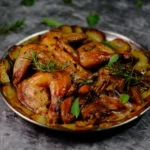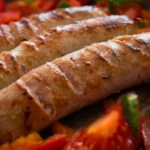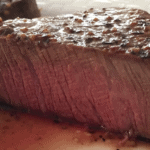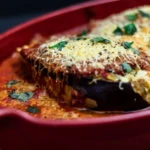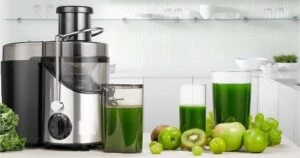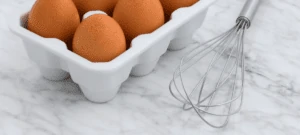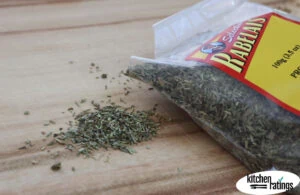If you are making a pie from scratch, your recipe may call for blind baking the crust and may also reference using baking beans.
What Are Baking Beans and How Do You Blind Bake?
Baking beans or pie weights are little balls, either dried beans or ceramic or metal beads, used to keep pastry crust from puffing during blind baking.
Commercial weights are made from heat conducting ceramic or metal, but dried beans like black beans can be used instead.
A slouched crust in the bottom of your tart tin is the saddest sight at the end of your first blind bake — but you can avoid the disaster with these magic beans. Warning: you might find yourself baking blind with confidence after you read this!
What Does it Mean to Blind Bake Pie Crust?
Baking blind doesn’t mean winging it with your eyes closed. Blind baking is the process of baking pastry crust without filling inside.
Final Thoughts Blind Baking
Pie crusts are usually baked without filling when an unbaked filling or wet filling is called for, like in pudding pies or pastries with chocolate ganache.
Another way to bake is to bake the crust upside down. This doesn’t call for beans but instead uses a smaller pie form placed inside of the crust for your pastry and left there while you bake the pastry.
How Do Pie Weights Work?
Baking beans, or weights, work by weighing down the empty pastry base while it bakes so it doesn’t puff up, develop air pockets, slip, or undercook. The medium size pieces are just enough to keep the pastry in shape like your recipe calls for.
Commercial beans are usually metal beads or ceramic beans (made of food safe ceramic stoneware). They conduct heat and help the pastry case to bake evenly.
Check out more on food safe cooking here.
What Are Baking Beans Substitutes?
Substitutes for commercial baking beans include beans, a large bag of rice (be sure to use dry rice), sugar, dried peas, or other dried pulses and dried foods.
Not all dried foods give the same result as commercial pie weights, and substitutes like rice, dried peas, though each a practical and colorful option, can’t be reused — they’ve passed their modal window. However, you can store them for when you bake the next time.
Popcorn kernels shouldn’t be used as weights in blind baking because you’ll probably end up with ready-to-eat popcorn instead of a beautiful, fully baked crust.
Sugar works well as a pie weight with double function if you want a golden brown, toasted sugar coating on your crust.
Loose change is discouraged as a blind baking crust weight because it isn’t food-safe. However, loose change does conduct heat well and can be used with baking paper, baking parchment paper or foil between the coins and the crust so it doesn’t come into contact with your pastry case.
Marbles can usually be used in place of ceramic beans, however, some apparently aren’t heat resistant and have been known to explode. We recommend only using products specifically designed for baking to avoid making a mess or harming someone.
Beans can’t be eaten after they’re used as weights in blind baking, but they can be used when you’re ready to bake again.
How Are Baking Beans Used?
Baking beans are used to easily fill empty pie when blind baking.
Step 1: Baking Paper
Use parchment paper or tin foil or aluminum foil to cover your pastry or pie shell.
Step 2: Clean the Baking Beans, Pre Baking
Rinse the beans or baking beads in running water and pat them dry.
Step 3: Distribute the Baking Beans
Put one layer of baking beans on top of the parchment paper or foil so that the covered pastry is weighed down from edge to edge.
Usually, just a handful is plenty for a smaller pie form or a medium size one. Add a few more to cover a large pie area.
Step 4: Bake the Pastry Case in the Oven
Bake your pastry dough in the oven following your recipe, and with about one or two minutes on your remaining time, ensure the crust firm and that the edges are golden brown.
Step 5: Remove the Baking Beans
When your pastry case is done baking, remove a few of the baking beans with a spoon. You can remove all the beans with a spoon, or carefully lift them out with the parchment paper.
Ceramic beans, metal beans, beans, or any dried food will be hot to the touch after baking at high temperatures, so be careful.
Leave the crust on the pie tin or pie plate to cool completely before filling inside with your pie filling.
Step 6: Wash the Baking Beans and Store Them
After you use baking beans, let them cool then wash them with warm water and dish soap. Let them air dry then store them for your next baking escapade.
How to Clean Baking Beans?
Clean commercial baking beans in a bowl of warm water and a squirt of dish soap. Slosh them around and let them sit for a few minutes, then carefully dump them on a clean kitchen towel and let them air dry. Store in a closed container.
You can use regular dish soap, as we discuss in this article, to clean beans.
Where Can I buy Baking Beans?
Baking Beans or weights can be purchased in several stores that sell pie pans or other baking products. They can also be purchased online.

